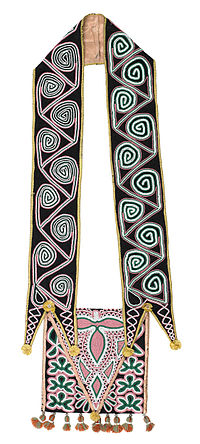Muscogee
The Muscogee or Mvskoke, Muscogee Creek are a Native American people from the Southeastern Woodlands. Today this is Tennessee, Alabama, western Georgia and northern Florida. Their languages are Muscogee, Mvskoke and Hitchiti-Mikasuki. The languages are part of the Muscogean language family. The Seminole people come from the Muscogee tribes. The Muscogee historically formed the Muscogee Confederacy.
 Muscogee Creek bandolier bag, c. 1820, Birmingham Museum of Art | |
| Total population | |
|---|---|
| 2010: self-identified 88,332 alone and in combination[1] | |
| Regions with significant populations | |
| United States: Alabama, Louisiana, Oklahoma, Texas | |
| Languages | |
| Muscogee, Hitchiti-Mikasuki, and English | |
| Religion | |
| Protestantism, Four Mothers Society, and others | |
| Related ethnic groups | |
| Muskogean peoples: Alabama, Koasati, Miccosukee, Yamasee, Chickasaw, Choctaw, and Seminole |
Social Structure
changeThe Muscogee Confederacy included several Upper Towns and several Lower Towns. Abihka, Coosa, Tuckabutche, and Coweta were the four earliest towns.
The Muscogee Confederacy had particular social structure. The social unit was the town (idalwa). The mico was village chief and most important man. Micos were warriors. Micalgi were lower chiefs. The heniha was second in charge. The tustunnuggee were ranked warriors. The clan was another social group. They dealt with land, hunts, marriages and crimes.[2]
History
changeEarly Muscogee were part of the Mississippian culture. They built cities and were mound builders. Notable mound sites are the Ocmulgee, Etowah Indian Mounds, and Moundville sites.
Spanish were early Europeans to meet the Muscogee in the 16th century.
Natives had interpretations for two special events. One was the Great Comet of 1811. The other was the 1812 New Madrid Earthquake. Many thought the events meant that they should support the Shawnee.[3]
There was conflict between the Upper and Lower Towns of the Muscogee. This eventually lead to the Red Stick War (Creek War, 1813–1814). It was connected to the War of 1812. Europeans also got involved in the war. Shawnee leader Tecumseh led the Northern towns. They lost against the Southern Muscogee and General Andrew Jackson. In 1814, the Muscogee signed the Treaty of Fort Jackson. They had to give up a lot of land.[4] The Muscogee spread out to different regions after this. Several went to Florida.
In Florida, Andrew Jackson attacked the Seminole in 1817. The Natives had been raiding towns. The Seminole lost and many moved inland.[5]
The Muscogee were forced to leave their homes during the Trail of Tears in the 1830s. Most went to Indian Territory (Oklahoma). Some remaining Muscogee moved to Florida and formed the Seminole. Also many of these Seminole were forced to leave. Some moved south to the Everglades.
The Muscogee were considered part of the so-called "Five Civilized Tribes". The Europeans saw how technologically advanced these natives were and thought they were civilized.
Opothleyahola was a chief of the Muscogee during the American Civil War. He wanted that the Muscogee stay neutral. Later they supported the Union and blacks.[6]
References
change- ↑ "2010 Census CPH-T-6. American Indian and Alaska Native Tribes in the United States and Puerto Rico: 2010" (PDF). census.gov. Retrieved February 7, 2015.
- ↑ O'Brien, Sharon. American Indian Tribal Governments. United Kingdom: University of Oklahoma Press, 1993.
- ↑ "The Creeks." Archived November 18, 2005, at the Wayback Machine War of 1812" People and Stories. (retrieved July 28, 2022)
- ↑ Brands, H. W. (2005). Andrew Jackson: His Life and Times. New York, NY: Knopf Doubleday Publishing Group. pp. 233–235. ISBN 978-1-4000-3072-9.
- ↑ Merwyn Garbarino, The Seminole Pg. 40
- ↑ "Woodson County history". Archived from the original on June 28, 2022.